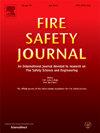An experimental study on the suppression of shielded fires by water mist sprays in a compartment
IF 3.4
3区 工程技术
Q2 ENGINEERING, CIVIL
引用次数: 0
Abstract
This study investigates the effectiveness of water mist systems in extinguishing shielded fires aboard marine vessels. Experiments were conducted in a standard ISO 9705 room, modified to simulate a scaled-down version of a ship engine room. A series of ten benchmark experiments were conducted varying the size of the fuel tray, ventilation in the room, presence of obstruction and its size, and suppression of the fire. Heptane was used as fuel and water mist nozzles were employed for fire suppression. The heat release rate, temperature, thermal radiation and oxygen concentration were measured during the experiments. The results showed that the water mist spray of 22 lpm extinguished a reasonably large fire of 570 kW quickly, even when the fire was shielded with a 1.4 × 1.4 m obstruction. After activation of the spray the concentration of oxygen also reduced to below combustion requirements. Key findings highlight the capability of water mist in suppressing shielded fires effectively, despite the complexities introduced by obstructions. The water mist showed an outstanding ability to reduce heat release rate, lower radiation and temperature levels, and decrease oxygen concentrations to below combustible levels, effectively extinguishing fires in compliance with established pass/fail criteria for maritime fire suppression. The data of these experiments can serve as a benchmark for validating numerical and analytical fire models.
隔室水雾喷雾灭火实验研究
本研究探讨了水雾系统在船舶上扑灭屏蔽火灾的有效性。实验是在一个标准的ISO 9705房间中进行的,经过修改以模拟船舶机舱的缩小版。进行了一系列的10个基准实验,改变了燃料盘的大小,房间的通风情况,障碍物的存在及其大小,以及对火灾的抑制。以庚烷为燃料,采用水雾喷嘴灭火。实验过程中测量了放热速率、温度、热辐射和氧浓度。结果表明,即使火灾被1.4 × 1.4 m的障碍物遮挡,22 lpm的水雾喷雾也能迅速扑灭570 kW的大火。喷雾活化后,氧的浓度也降低到燃烧要求以下。关键发现强调了水雾有效抑制屏蔽火灾的能力,尽管障碍物引入了复杂性。细水雾显示出降低热释放率、降低辐射和温度水平、将氧气浓度降低到可燃物水平以下的卓越能力,有效地扑灭火灾,符合既定的海上灭火合格/不合格标准。这些实验数据可以作为验证数值和分析火灾模型的基准。
本文章由计算机程序翻译,如有差异,请以英文原文为准。
求助全文
约1分钟内获得全文
求助全文
来源期刊

Fire Safety Journal
工程技术-材料科学:综合
CiteScore
5.70
自引率
9.70%
发文量
153
审稿时长
60 days
期刊介绍:
Fire Safety Journal is the leading publication dealing with all aspects of fire safety engineering. Its scope is purposefully wide, as it is deemed important to encourage papers from all sources within this multidisciplinary subject, thus providing a forum for its further development as a distinct engineering discipline. This is an essential step towards gaining a status equal to that enjoyed by the other engineering disciplines.
 求助内容:
求助内容: 应助结果提醒方式:
应助结果提醒方式:


